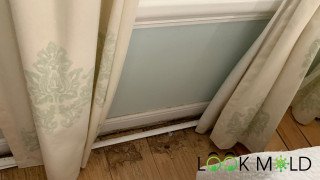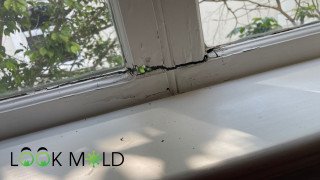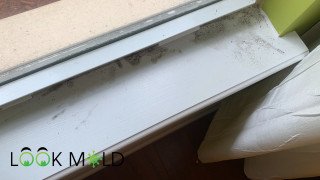Professional Mold Remediation Services
Don't Let Toxic Mold Put Your Family's Health at Risk
Stop mold damage before it spreads. Call now for a free, no-obligation estimate from a local remediation expert.
Free Estimate · Zero Obligation · Available 24/7
Black Mold on Windows: Is It Harmful and How to Prevent It?
Mold on windows, is caused by excess moisture and comes in various colors. The presence of mold found on windows is typically harmless on non-porous materials such as glass and metal because the mold cannot thrive to create mycotoxins. Mold found on porous surfaces such as wooden window frames can be cause for concern.
Mold growth on windows and surrounding areas could be a problem in certain situations that you need to be aware of.

In this article we will go over:
- Is Mold on windows dangerous
- Why Mold grows on windows
- Mold Removal on Windows
- Ways to prevent mold from growing on windows
Is Mold on Windows Dangerous
To determine if mold on windows in a home is dangerous, it’s important to first understand the different components of a window because mold does not treat every part of the window system the same.
While mold on one part of a window may be not a big deal, another part of the window can be worrisome.
Here are the most common parts of the window that mold can grow on:
Window Panes- Window panes are usually made of glass. Glass is not porous so any mold present on the pane is on the surface only and not dangerous
Window Frames- Window frames are usually made of aluminum or wood. Mold growing on aluminum window frames is not an issue because it’s non porous surfaces. Wood window frames, on the other hand, can be an issue because mold can grow and thrive on wood.
Window Casings- Mold on window casings may be an issue because it's usually made of wood
Window Reveal- Window reveals are typically made of drywall, plaster, or wood. Drywall and wood support mold growth while plaster does not
Window Sills- Mold on a window sill can be a problem because it's typically made of mold.
Window Tracks- Dirt tends to build up in the window tracks which can have microbial growth present on them.
Underneath the Window- Mold under windows is the biggest area of concern. This is because mold can be on drywall and cause black mold and other types of dangerous species of mold to grow. Mold can also get behind the baseboard and thrive.
Basically, any part of the window that is porous and wet, can potentially allow mold growth.
Why Does Mold Grow On Windows?
Mold thrives under damp conditions. Considering that the exterior has a lot of moisture, it would make sense for mold to build up on it.
But here's the thing:
Mold doesn't get inside the windows because of moisture from the outside all the time. It's sometimes something else...
The combination of warm temperatures inside the house and cold temperatures outside (or vice versa) creates a dew point on the windows and all their components. The dew point leads to excess moisture which is turn can lead to microbial growth.

All the moisture surrounding the windows makes it an ideal environment for mold spores to grow. Additionally, dirt and dust particles that accumulate around window frames provide additional food sources for molds.
Mold can grow underneath windows and on a window due to water intrusion. The water intrusion can be around a window frame due to rotted wood on the exterior. If the water sits on the window sill, wood rot can also be present.
Water can also get in around window caulking that is deteriorating on the exterior. Once water gets inside the wall under the window, if drywall is present, toxic black mold can start to grow.
Mold Removal on Windows
Because mold on some building materials can be more serious than others, you can't take care of mold problems the same on every part of the window.
For example, you won't use the same solution on window glass as you would on wooden sills.
Before cleaning any surface affected by mold, be sure that all safety precautions are taken. One must wear protective gear such as rubber gloves and goggles when handling potentially hazardous materials like bleach or vinegar solutions used for cleaning purposes.
If you have visible evidence of black mold under the windows, don't even attempt to treat mold in this scenario. A mold remediation professional should be called.

Removing mold from your window can be a tricky task, but with a little bit of know-how, you can make it a breeze. You only want to treat visible mold on non-porous materials using the following methods outlined. Here are a few things to keep in mind before diving in:
-
Safety first! Mold spores can spread quickly and cause mold allergies, so be sure to suit up with protective clothing such as safety goggles, rubber cleaning gloves, and a face mask (an N-95 respirator will do the trick).
-
Pick the right products. Not all cleaning products are created equal when it comes to mold removal. Look for products that not only remove the surface mold but also prevent it from growing back.
How to Clean Mold from Windows Naturally?
Mold on a window or window sills can be a common problem for homeowners. There are several natural methods for removing mold from windows without using harsh chemicals or cleaners.
Clean Mold With Vinegar in a Spray Bottle
Vinegar is an effective way to kill and remove mold from window sills naturally.
-
Simply mix one part white vinegar with four parts water in a spray bottle and apply the solution directly onto the affected area.
-
Let sit for 10 minutes before wiping away with a cloth or sponge. The acidity of the vinegar will help to kill off any existing mold spores while also preventing new ones from forming.
Baking Soda Solution
Baking soda is another great option for killing and removing mold from windows naturally.
-
Mix together equal parts baking soda and water until you have created a paste-like consistency.
-
Spread this mixture over the affected area and let sit for 15 minutes before scrubbing away with a damp cloth or sponge.
-
The abrasive nature of baking soda helps to break down any existing mold spores while also helping to prevent new ones from forming in the future.
Tea Tree Oil
Tea tree oil has natural antifungal properties that make it an ideal choice for killing off existing mold spores as well as preventing new ones from forming on your window surfaces in the future.
-
To use tea tree oil, simply mix 1 teaspoon of tea tree oil into 2 cups of warm water in a spray bottle.
-
Apply directly onto the affected area and let sit for 10 minutes.
-
Wipe away with a damp cloth or sponge.
Hydrogen Peroxide
Hydrogen Peroxide is another effective way to kill off existing mold spores as well as prevent new ones from growing on your windows.
-
This is done by breaking down their cell walls, which prevents them from reproducing further growths of fungus or mildew colonies within your home environment.
-
To use hydrogen peroxide, simply mix 1 cup of hydrogen peroxide into 4 cups of warm water inside a spray bottle and apply directly onto the affected areas.
-
Let sit for 10 minutes before wiping away with a damp cloth or sponge.
Lemon Juice and Warm Water
Lemon juice contains citric acid which makes it an excellent choice when looking to remove stubborn stains caused by mold growth on non-porous surfaces.
-
To use lemon juice, simply combine equal parts lemon juice and warm water inside of spray bottle
-
Shake vigorously, then apply directly onto stained areas.
-
Let it sit for up to 30 minutes before scrubbing gently with a soft brush followed by rinsing clean using lukewarm water.
By following the simple steps outlined in this article, you can safely and naturally remove mold from window sills. Now let's look at whether or not it is harmful to have mold on windows.
Keep in mind, don't overdo with water because water is what causes mold growth to begin with. If you use too much water you run the risk of black mold on windows, or at least under them!
How to Get Rid Of Mold on Window Sills and Window Frames
Because most window sills and window frames are made of wood, you can't just treat all the mold. In many cases, the best case would be to seal the mold with an anti-microbial coating. You would just paint the solution on the affected area.
And remember, protective gear is crucial!

How To Prevent Mold Growth On Window Sills?
In order to prevent mold on windows can be done by doing one thing...
Controlling moisture.
Humidity Control
Moisture and humidity play a crucial role in the development of mold on windows and window sills. As stated earlier, when warm air comes into contact with cold surfaces like window frames or glass panes, it causes condensation to form on the surface.
This moisture provides an ideal environment for mold spores to grow and thrive. Additionally, high levels of indoor humidity can also contribute to increased levels of condensation forming on window surfaces due to temperature differences between inside and outside air temperatures.
Running your air conditioning consistently can prevent excess mold by controlling humidity in the home.
Keeping Window Clean
Window sills and tracks often accumulate dirt or debris over time from dust particles floating around in the air or from other sources such as pet hair or dead insects accumulating near window sills where they may be difficult to clean up regularly by homeowners themselves without professional help if needed.
These materials act as food sources for molds which then use these organic materials as nutrients while growing rapidly under moist conditions caused by condensation forming on window surfaces due to their exposure outdoors when opened up at times during warmer months.

Ventilation
Poor ventilation is another factor that contributes to increased chances of mold growth on windows. Poor ventilation increases indoor humidity levels, making it easier for moisture droplets formed by condensation to stick onto window frames and providing a perfect breeding ground for molds looking for food sources nearby.
Even with regular cleaning practices, homeowners cannot completely prevent this issue unless proper steps are taken regarding the installation of ventilation systems inside homes.
In bathrooms where humidity is the highest, using the exhaust fans is crucial.
Moisture and Organic Material
Visible mold can grow on windows due to the presence of moisture and organic material, making it important to identify the source of the mold and take steps to prevent it from growing in the future.
Conclusion
It is important to take steps to prevent mold growth on windows by ensuring proper ventilation and cleaning regularly. If you find mold on your windows, it is best to take action quickly before the problem gets worse. Cleaning up the mold yourself may not always be an option especially when drywall is wet, so make sure you contact a professional if necessary. With proper prevention and maintenance, you can keep your home free of any potential risks associated with mold on windows.
Explore Related Topics:
Notice an update we should make?
We strive for accuracy. Contact us here if you see incorrect or outdated info on this page.
